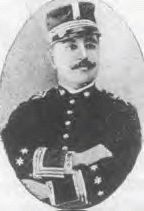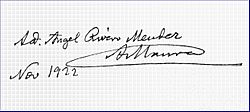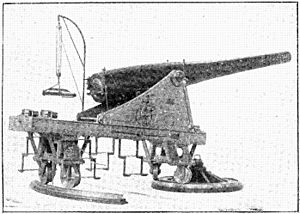Ángel Rivero Méndez facts for kids
Quick facts for kids
Ángel Rivero Méndez
|
|
|---|---|

Captain Ángel Rivero Méndez
|
|
| Born | October 2, 1856 Trujillo Bajo, Carolina, Puerto Rico |
| Died | February 23, 1930 (aged 73) Cuevas, Trujillo Alto, Puerto Rico |
| Buried |
Santa María Magdalena de Pazzis Cemetery, in San Juan, Puerto Rico
|
| Service/ |
Spanish Army |
| Years of service | 1882–1898 |
| Rank | Captain |
| Commands held | 3rd Company of the 12th Artillery Battalion at Fort San Cristóbal |
| Battles/wars | Spanish–American War |
| Awards | Cruz de la Orden de Mérito Militar 1ra Clase distinción Rojo (Order of Military Merit 1st Class) |
| Other work | Invented Kola Champagne |
| Signature |  |
Ángel Rivero Méndez (born October 2, 1856 – died February 23, 1930) was an important Puerto Rican figure. He was a soldier, writer, journalist, and a businessman. Rivero Méndez served as a Captain in the Spanish Army. He was involved in the Spanish–American War. He is known for ordering the first shot fired against the United States in Puerto Rico during that war.
After the war, he became a U.S. Citizen. He also wrote a book about the war called Crónica de la guerra hispano-americana en Puerto Rico. Ángel Rivero Méndez is also famous for inventing a popular fizzy drink. It is called Kola Champagne and is still sold today.
Contents
Early Life and Education
Ángel Rivero Méndez was born in Trujillo Bajo. This is a neighborhood in Carolina, Puerto Rico. His parents, Rosa Méndez and Juan Rivero, came to Puerto Rico from the Canary Islands. He was baptized into the Catholic faith on his birthday, October 2, 1856.
Rivero Méndez went to school at the "Colegio de Jesuitas" in Santurce. Santurce is a part of San Juan, the capital of Puerto Rico. After finishing school, he joined the Spanish Army. He then attended the Infantry Academy of Puerto Rico. He became an officer on August 2, 1882.
In 1882, Rivero Méndez married Manuela Boneta y Babel from San Juan. A few years later, in 1885, he was accepted into the General Military Academy of Toledo in Spain. While there, he wrote a book about the city of Toledo, Spain. In 1886, he moved to the Academy of Artillery in Segovia. He earned a degree in Industrial Engineering in 1889.
Military Service
On January 1, 1890, Rivero Méndez returned to Puerto Rico. He was assigned to the 12th Battalion of Plaza. He also taught at the Military Preparatory Academy in San Juan. In 1896, he was promoted to the rank of captain.
As a captain, he taught math and chemistry at the Civil Institution of Secondary Education. He also became involved in politics. He was a member of the Unconditional Spanish Party. Rivero Méndez started a newspaper called La Integridad Nacional. This paper shared the party's political views. Later, he and others left the party and formed a new one. Rivero Méndez wrote an article that criticized the government. This led to his arrest. However, due to rumors of war, he was pardoned by Governor Macias. On March 1, 1898, he was given command of the 3rd Company of the 12th Artillery Battalion. This unit was stationed at Fort San Cristóbal in San Juan.
Spanish–American War
When the United States declared war on Spain, the U.S. Navy sent a ship called USS Yale. Its job was to block the port in San Juan Bay. On May 10, 1898, Captain Rivero Méndez ordered his soldiers to fire at the Yale. This was the first attack against the Americans in Puerto Rico during the Spanish–American War.
For his actions, he received a special award. It was called the "Cruz de la Orden del Mérito Militar 1ra Clase con Distintivo Rojo" (The Cross of the Order of the Military Merit first class). Some people in San Juan were upset with Rivero Méndez. They blamed him for the damage caused by the American ships firing back. However, nothing came of these accusations.
Battle of Fajardo
On August 1, 1898, a U.S. Navy ship called USS Puritan was sailing near Fajardo. Its commander, Captain Frederic W. Rodgers, saw the Cape San Juan lighthouse. This lighthouse was supposed to be where the U.S. Army would land in Puerto Rico. Captain Rodgers sent some of his men ashore. These included Puerto Rican volunteers. Their mission was to raise the American Flag on top of the lighthouse.
The next day, August 2, three more U.S. ships arrived. They were USS Amphitrite, USS Leyden, and USS Hannibal. The 25 Spanish soldiers in Fajardo learned about the Americans. They told their commanders in San Juan and were told to leave. Dr. Santiago Veve Calzada, the mayor of Fajardo, saw that his city was unprotected. He asked the Spanish authorities in San Juan to send troops. When he thought no help would come, Dr. Veve Calzada went to the lighthouse. He asked the Americans for protection for his city. On the afternoon of August 3, Dr. Veve Calzada returned to Fajardo. He was with some Marines. The United States flag was then raised over the Fajardo Customs House and City Hall.
Captain Rivero Méndez was ordered to check on the situation in Fajardo. He was told that the Americans had left the city. He was also told it would be easy to capture the people of Fajardo who had helped the Americans. Rivero Méndez shared this information with General Ortega. General Ortega suggested that General Macías should take the town with 200 soldiers and cannons. Macías was told to capture Dr. Veve and everyone involved in the revolt. This included the Americans at the lighthouse, even if it meant destroying the lighthouse. However, General Macías refused to follow Ortega's plan.
On August 4, Governor General Macías sent Colonel Pedro del Pino and 200 men to take back the city. When Colonel Pino entered Fajardo, it was almost empty. The residents, fearing a battle, had fled to the Fajardo lighthouse. Pino waited until dark. Then he ordered his men to attack the lighthouse. The Marines at the lighthouse signaled their ships for help. The ships then started firing cannons at the shore to protect them. The Spanish forces had to retreat back to the city.
The next day, U.S. Marine Lieutenant John A. Lejeune came ashore. He brought more Marines. They helped the civilians and Marines leave the lighthouse. They were taken to Ponce, and the lighthouse was left empty. Meanwhile, in Fajardo, Colonel Pino's men took down the U.S. flags. These flags had been flying over the Customs House and City Hall. They returned to San Juan, showing the flags as war trophies. This was the only time American forces had to leave a position during the campaign in Puerto Rico.
End of the War
Spain surrendered, and Puerto Rico became a territory of the United States. This happened because of the Treaty of Paris of 1898. On October 18, 1898, Rivero Méndez was told to hand over the keys to all military buildings in San Juan. He gave them to Captain Henry A. Reed of the U.S. Army.
Both the American and Spanish governments offered Rivero Méndez a military job. He said no to both offers. On April 18, 1899, he officially retired from the Spanish Army. Newspaper reports from his obituary say that he served as governor of Puerto Rico for two days. After the war, Rivero Méndez became a U.S. Citizen.
Later Years and Inventions
Kola Champagne
In 1902, a few years after the Spanish-American War ended, Rivero Méndez started a soda factory. It was called El Polo Norte Fábrica de Sodas (The North Pole Soda Factory). Here, he created Kola Champagne. This became a very popular soft drink in Puerto Rico. While he was making the drink, he also worked on his book. It was called Chronicle of the Spanish-American War in Puerto Rico. Today, Kola Champagne is made and sold by Goya Foods, Inc. in the United States and Mexico. Other countries like Colombia and Jamaica have also made this drink.
Author
Rivero Méndez spent many of his later years gathering information for his book. The book was about the Spanish–American War in Puerto Rico. He also wrote articles for newspapers like El Imparcial, El Mundo, and La Correspondencia de Puerto Rico. In these articles, he supported Puerto Rican nationalism and the idea of Puerto Rican independence. In 1922, Rivero Méndez published his book, Crónica de la Guerra Hispano Americana en Puerto Rico. This book is considered one of the most complete works about that war.
Rivero Méndez and his wife were very devoted to the Virgin of Lourdes. In 1924, he built a special shrine dedicated to her. It was on his land in Trujillo Alto. This shrine is still standing today and is an important landmark. It was blessed by San Juan's Bishop Jorge Caruana on January 6, 1925.
Death
Ángel Rivero Méndez passed away on February 23, 1930. He was 73 years old. His body is buried in the Santa María Magdalena de Pazzis Cemetery in San Juan, Puerto Rico.
Military Award
This is the military award given to Rivero Méndez:
 Cruz de la Orden del Mérito Militar 1ra Clase con Distantivo Rojo (Order of Military Merit 1st Class)
Cruz de la Orden del Mérito Militar 1ra Clase con Distantivo Rojo (Order of Military Merit 1st Class)
See also
 In Spanish: Ángel Rivero Méndez para niños
In Spanish: Ángel Rivero Méndez para niños
- List of Puerto Ricans
- List of Puerto Rican military personnel
- Puerto Rican Campaign
- Military history of Puerto Rico
- Puerto Rican scientists and inventors






